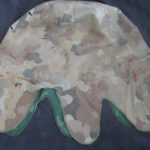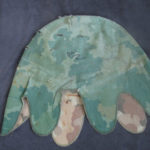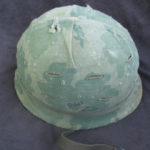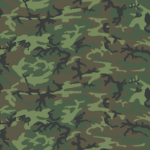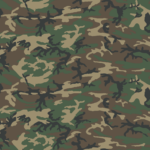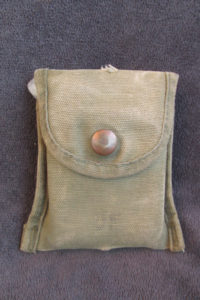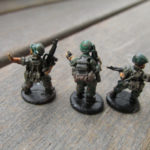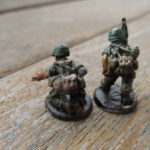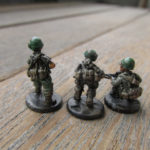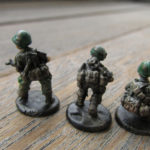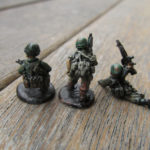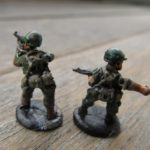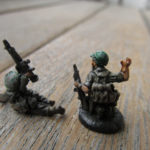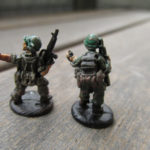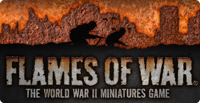with Jukka Salonen
When we think of Marines and the Vietnam war, we often picture them in Olive Green battle uniforms and webbing. Tiger-stripe camouflage… The whole works. To a part this is true thing, but there is much more than that. This article is written with the thought that even though Marines are mean and green, there is much more to them, colour-wise, than that.
Camouflage
The Marines entered the Vietnam conflict in 1965. When they arrived, they did not have camouflage, except on their helmets. The helmets used the so-called “wine leaf pattern” camouflage helmet cover. It was two sided: Green Brown and a cloudy brown pattern. This pattern was designed originally in 1953, and reminds of the older WWII patterns used in the Pacific theatre. This pattern was only made for helmets and shelter halves and used by both the army and the Marines. It was also copied by private companies in the far east, and along with the cannibalizing of old camouflaged gear, found itself sewn into other gear by custom tailoring.
In 1948, the US Army Engineer Research and Development Laboratory, aka. ERDL, designed a new camouflage uniform pattern. This is usually called ERDL camouflage, or just ERDL. A pattern that looks a lot like the later US woodland pattern, which is basically a magnified ERDL print. The clothes with this pattern were doled out in 1967 to special forces and also saw use with ANZAC special troops. But what is important to us is that it was also favored by the US Marines. The camouflage pattern itself was also nicknamed ‘Leaf pattern’ or ‘Flower Power fatigues’. The ERDL existed in a lighter, and darker version, respectively lowland and highland versions. Apparently Marines favored the lighter lowland version.
However you decide to paint your troops, remember that clothes received far tougher use than our clothes get. In first-hand stories from different wars, from the Finnish winter war to the war on terrorism in Afghanistan, the pants appear to be the first uniform piece to wear out. So many Marines might just wear the top or the bottom of the ERDL pattern uniform instead of the full set.
But do remember, once the ‘flower power’ fatigues started to be doled out it started to become rarer and rarer to see Marines in green uniforms. By 1970 camouflage uniforms were the standard. Mother Nature’s green killing machines started to blend in.
Salty Gear
Marines liked their gear to look used. Or salty, as they themselves say. Salty means, amongst other things, gear that has seen use and thus gives its wearer an air of being experienced. Older, worn uniforms are also thought to be more comfortable.
This means the color on the webbing and gear might vary in all the glorious colours of the stained sweated-or-bled-on colour palette. A Marine might have packed even old WWII-era gear just because it was thought of as salty. The original Marine webbing in Vietnam was the old WWII M1945-webbing. But Marine Command had made the nice gesture and added the army WWII shoulder paddings to the original webbing. All pieces were re-coloured before being issued, and apparently, some of it is still stored unused into the present day. At least my original M1956 webbing suspenders of my reenactment kit came to me unused. Later, the Marines started receiving the M1956 webbing used by the army since the early 60s. Later on everybody started receiving the modernized M1967 gear, designed specially for the Vietnam conditions. Canvas rotted in the jungle, and weighed more especially when wet- the M1967 Nylon ones did not have any of these problems.
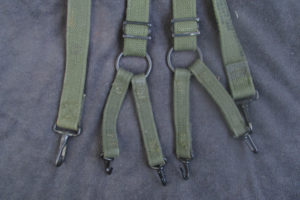
The pistol holsters and knife sheaths were leather, so they should probably be either brown or black or something in between, with black being the more common post-WWII. Even though the Ka-Bar knife’s sheath is mostly brown, leather becomes more and more black when it meets sweat and mud. Pistol holsters seem to have been black at this point, but brown was the usual color in the previous conflicts. The boots were black, so called ‘jungle boots’ which had green canvas pieces were also used, so there is a challenge for those who want to paint small details.
Marines used the leaf pattern helmet cover, but they might also have at times gone without the helmet cover. Similarly, the helmet band was not used in the beginning of the conflict. Early helmets could have had a black band made of the inner tube of a tire. Even when the helmet-band was available it lacked the “cat eyes” reflectors the modern ones have. The helmets were often graffiti clad and could also have foliage added on them, but foliage is rarely seen in photos.
But be the gear old or new, there was always the idea of saltiness. So at least a part of the gear could (or maybe even should?) be painted more worn and scruffy. Also, the colors on the non camouflaged gear seem to have varied a tad, depending on the exact model and make. Quite like the German WWII uniforms you often see the pictures of. Google up for example utility shirts of models P53, P56, P58, and P63, and they all have a different tone of “military green.” So if you don’t have the exact right green tone on a short sleeved shirt. It really is nothing. It might even be white, but insanely dirty in that case. (And now I´m thinking about painting one miniature that way!)
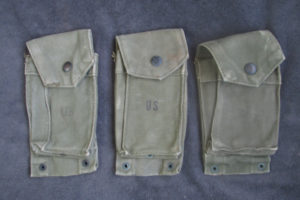
The Marines were also notorious termites. Apparently they traded or “borrowed” gear they were not issued with if they thought they needed it, regardless of their webbing model. So even if the ‘Nam miniatures are kitted out in the new model webbing, one should not be shy to paint an odd pouch in a different color. Or for example an odd piece of pants in an allied force camouflage. Other camouflage patterns could be tiger-stripe, the south-Vietnamese airborne pattern and different blotchy “duck hunter” patterns. But I feel these would be few and far between on regular grunts. So a full grunt platoon in “duck hunter”, would not be plausible, but recon units would be a different waltz all together. They would be kitted mostly in full camouflage. I at least intend to try several patterns mixed out on my recon team.
But before you go all out and start making every figure an exception, with a multitude of different camouflaged gear. STOP! DO NOT! Though there were exceptions, make them here and there. If you make every miniature with a lot of differences, you end up with something looking in the best case like a special forces unit, and in the worst case like a post apocalyptic raider unit.
The camouflages mentioned here were worn only by people. Vehicles were all the colourful variations of worn olive drab.
And do not forget the mud and dust. Depending on which movies you have seen, the Vietnam war was muddy or dusty. A light dry brush hinting of mud or dust looks good on boots and the legs of the pants, or even here and there on elbows, bag bottoms… you get the picture.
So far I have painted only leaf pattern helmets and some odd clothes (even one full leaf pattern uniform.) The lighter version I start with a base of some natural dark green color. After that, I apply blotches of Green Grey, and a handful of stripes in some brown tone. Then I give it a light Black Wash to bring out all the details. And after that, a spider web thin layer of an lightly uneven White dry brush (maybe with a tad Green Grey mixed in if I feel like it) to make it more scruffy looking.
I have not yet painted any darker versions of the vine leaf pattern since I go with the “Vietnam was wet and muggy” version. So I can not give any tested ideas on how to paint. But it is just basically four different sandy color tones, painted in big, cloud-like blotches.
When painting the webbing, I usually make three paint stripes besides each other on the palette. One being Olive Drab, the other being something browner, and the other a lighter tone of the same. I dip the brush in one, and swipe left or right. Mix it together and paint as many webbing details with it, giving all the webbing have a slightly used tone. After that I apply black ink and a light dry brush with White and Brown-Green mix.
Here and there you might add some random things in colors from the US WWII late war painting guides to give it more variance, and do not forget the grenades. They were mostly olive drab, with a yellow stripe. Sometimes the rifles also had some kind of camouflage stripes on them. It was mostly a special forces thing, and there it seems to me to be mostly an ANZAC thing. But one or two rifles in a platoon would not look, to me, out of place.
As a conclusion I could say that if you are not sure what color something should have, paint it Olive Drab or Olive Green. And then dry brush it to make it look salty.
On the more exotic ideas, the field is yours to try out. Be sure to post pictures of them, and I’ll leave you with a few photographs of what I’ve gotten done so far.
Sources:
Osprey publishing. Warrior 23. US Marine Rifleman in Vietnam 1965-1973. Melson, Bujeiro.
Osprey Publishing. Battle Orders 19. The US marine corps in the Vietnam war. Gilbert. Anderson.
http://camopedia.org
Vietnamgear.com
I also would like to thank the Terminal Lance webcomic, on helping me understand better the many faceted USMC sub-culture.
Extras For Experts
Battlefront Studio Painter Aaron also recommended a few videos for those who want to check out more ‘Nam gear for information or inspiration:
